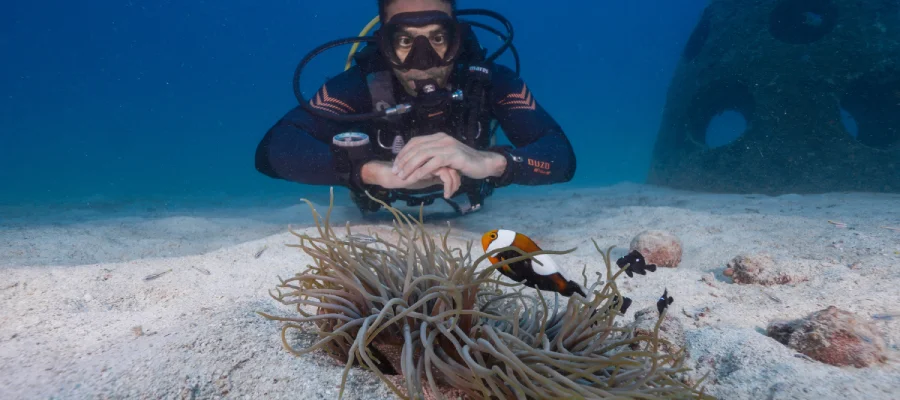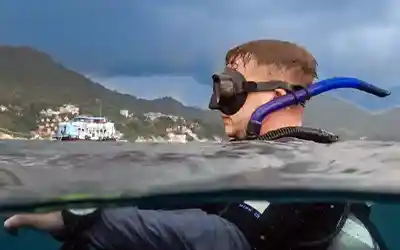Best Time to Dive Koh Tao: What to Expect of Koh Tao Diving Season by Season
Picture this – you’re at home on a chilly morning, staring out the window before another work shift, dreaming of warm sunshine, turquoise waters, and an unforgettable underwater adventure in Thailand. It’s time for a vacation, but when is the best time to dive Koh Tao?
Known as one of the best dive destinations in Southeast Asia, the island of Koh Tao attracts thousands of divers each year with crystal-clear waters, vibrant coral reefs, and abundant marine life. But even paradise has its seasons. Rain is inevitable, though far more likely in some months than others, and Koh Tao’s rainy season is different from west-coast spots like Phuket or Koh Phi Phi.
At Crystal Dive, we’ve been living Koh Tao’s dive conditions for 25 years. We know exactly when to dive Koh Tao and how each season affects visibility, dive planning, and the marine life you’re most likely to encounter. So, let’s dive into the best time to visit Koh Tao and help you plan the perfect trip
Best Time to Dive Koh Tao at a Glance
| Months | Water Temp | Visibility | Surface Conditions | Marine Life Highlights |
|---|---|---|---|---|
| Jan - Feb | 27–28°C | 10–15m | End of monsoon season - varied conditions | Big schools of reef fish |
| Mar - May | 29–30°C | 15–30m | Generally, very calm, flat, and very sunny | Whale shark season, coral spawning |
| Jun - Sep | 29°C | 15–25m | Increased wind in June - wavey days possible | Whale shark sightings are still common |
| Oct - Dec | 27–28°C | 5–10m | Monsoon season - seas can be unsettled - conditions vary | Good season for macro life and muck dives in sheltered bays |
Koh Tao Diving Season Overview
Koh Tao enjoys a warm, tropical climate year-round, but the diving conditions shift with the island’s two monsoon cycles. While rain can fall during any month, these two seasonal patterns influence underwater visibility, water temperature, marine life sightings, and even which dive sites are accessible. Understanding how each monsoon affects the Koh Tao diving season can help you plan a trip that matches your diving style and goals.
Southwest Monsoon (May – September) – Brings occasional windy days, short bursts of rain, and slightly choppier seas. Underwater conditions are often very good, but periods of wind or sudden rainstorms can cause temporary drops in visibility. During this time, winds come from the west, so dive centres head to sheltered sites on the island’s east coast when the winds are too high. This shift in location often offers a chance to explore less-visited dive sites with unique coral formations and marine life.
Northeast Monsoon (November – December) – Known for thunderstorms and heavy downpours that can lead to localized flooding. Runoff from intense rain often reduces visibility across local dive sites. While conditions remain diveable thanks to Koh Tao’s sheltered position in the Gulf of Thailand, divers should be prepared for less predictable weather, surface chop, and lower visibility.
Choosing the right diving season for your trip can mean calmer seas, clearer water, and the highest chance of seeing some of Koh Tao’s most popular underwater residents, from schooling barracuda to the awe-inspiring whale shark. For many visitors, timing their trip well can be the difference between a good diving holiday and an unforgettable one.
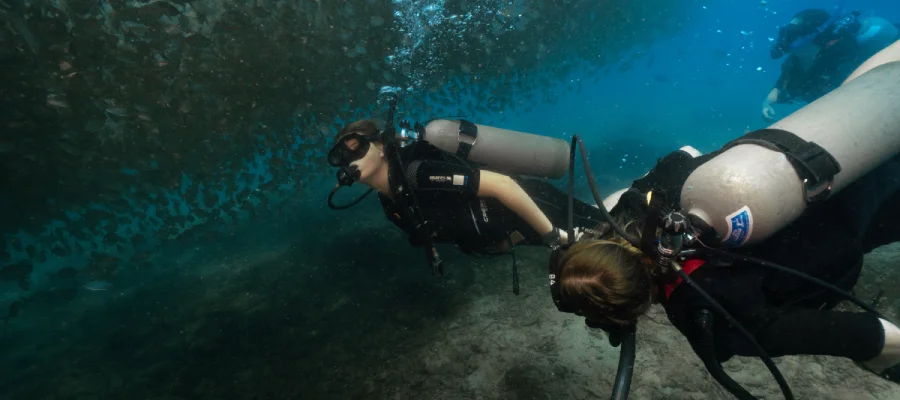
Season-by-Season Koh Tao Dive Conditions
December – February
This is the coolest time of year on Koh Tao, with air temperatures ranging from 24–28°C and water temperatures dropping sometimes as low as 26°C during the northeast monsoon. Koh Tao dive conditions can change quickly during this period, but december generally brings strong winds, frequent downpours, and reduced visibility due to rain runoff. While conditions are almost always diveable thanks to the island’s protected location in the Gulf of Thailand, surface conditions can be choppy, and some offshore sites may be skipped on windier days.
Monsoon typically eases in January, bringing calmer seas and improved visibility, though rain showers are still very possible. February is a favourite month for many experienced divers and underwater photographers. Seas can be glassy and mirror-like, and visibility can reach 20–25 metres. This season often brings schooling fish and pelagic sightings closer to shore.
Wetsuits are recommended, especially for multiple dives per day, as the cooler water can lower your body temperature faster than expected. Surface intervals can also feel a tad chilly in the wind, with locals often breaking out hoodies and windbreakers during December.
For divers who enjoy cooler waters and fewer crowds, this can be one of the best times to dive Koh Tao if you plan for the seasonal conditions.
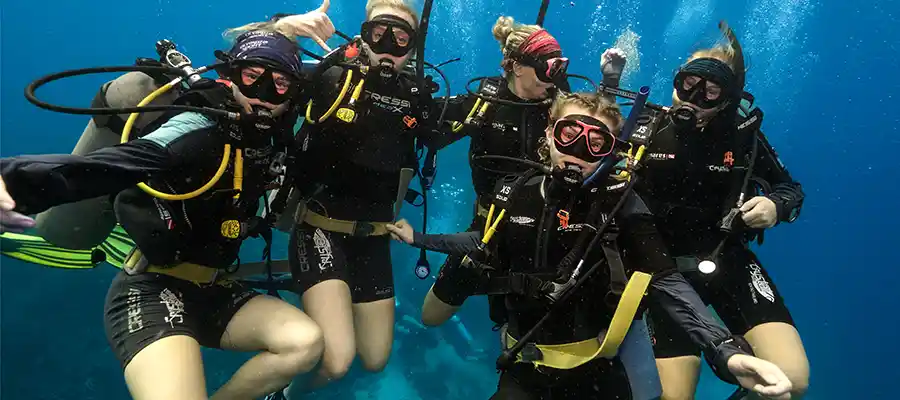
March – May
Widely regarded as the best time to dive Koh Tao, this is the peak of Koh Tao’s diving season. Air temperatures rise to 35°C+, and water temperatures climb back to about 30°C. Seas are typically calm, with light winds and minimal rain. Visibility often peaks at 20–30 metres, making it an ideal time for underwater photography.
Marine life sightings are spectacular during this period. This is whale shark season, thanks to plankton blooms triggered by warmer waters. Divers also encounter large schools of barracuda, fusiliers, and trevally, along with healthy reef activity from turtles, angelfish, and countless macro critters.
Surface conditions are generally perfect and calm enough for comfortable boat rides to more exposed dive sites like Chumphon Pinnacle or Southwest Pinnacle.
Because this is also the busiest tourist season, boats and beaches can be lively. Booking courses, fun dives, and accommodation in advance is strongly recommended. The warm water means most divers are comfortable in a shorty wetsuit or even just a rash guard, but a 3mm full suit can help with buoyancy control and protection against the occasional jellyfish.
For most divers, March to May offers everything you could ever want – stunning visibility, calm seas, and a very high probability of encountering Koh Tao’s most famous gentle giant.
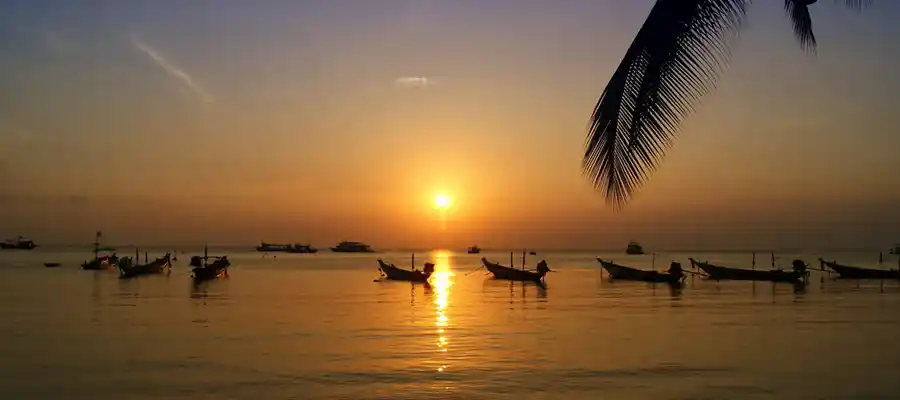
June – September
This period is often considered a shoulder season. It’s not high season but not quite low season either. The diving is still excellent, but with slightly more unpredictable weather patterns. The southwest monsoon influences the island from May through September, bringing occasional westerly winds, short rain showers, and choppier seas on the west side of the island. Knowing when to dive Koh Tao during these months can help you avoid choppy days and make the most of calm-weather windows.
Air temperatures are over 30°C, with water temperatures holding steady between 28–30°C. Visibility can range from 10–25 metres, depending on recent weather. June and July may see more frequent wind and waves, while August and September often bring surprisingly calm conditions and clear water.
Marine life remains diverse and active, with reef fish in abundance and occasional whale shark sightings early in the season. The slightly reduced tourist numbers compared to March–May mean dive sites are often less crowded, offering a more relaxed pace underwater.
This is also a great time for new divers to complete certification courses since conditions are generally decent, and there’s more flexibility in scheduling. Most overseas visitors find the water temperature quite comfortable and dive in just a bathing suit (although our staff may show up in wetsuits on some days).
If you want fewer crowds but still great visibility, this shoulder season might be the best time to dive Koh Tao for you.
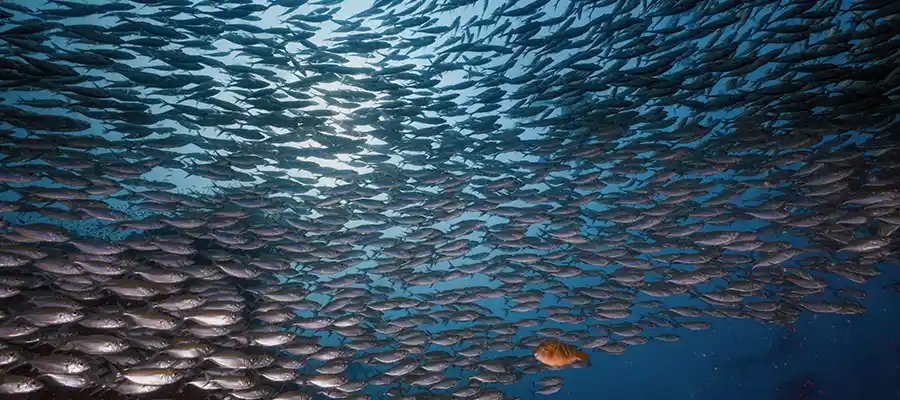
October – November
This is the northeast monsoon season, and the most challenging time of year for diving on Koh Tao. October often starts with hot, humid days and occasional calm seas before the monsoon intensifies in November. Rainfall increases, sometimes in heavy bursts that last for hours, and the wind shifts to the northeast.
Air temperatures drop to 26–30°C, and water temperatures can dip to 26°C. Heavy rains may reduce visibility to 5 metres or lower, especially near shore after periods of runoff. Seas can become rough, particularly on the east side, so dive boats typically head to sheltered west coast sites like Twins, Japanese Gardens, or White Rock.
While Koh Tao dive conditions are less predictable during this time, diving is still possible every day. Marine life remains abundant, and some divers enjoy the moody, sometimes creepy feel of the ocean during this time. The island is quieter, accommodation prices are often lower, and you’ll have many dive sites to yourself.
For adventurous divers who don’t mind trading visibility for solitude and a slower pace, October–November offers a different, more rugged side of Koh Tao diving.
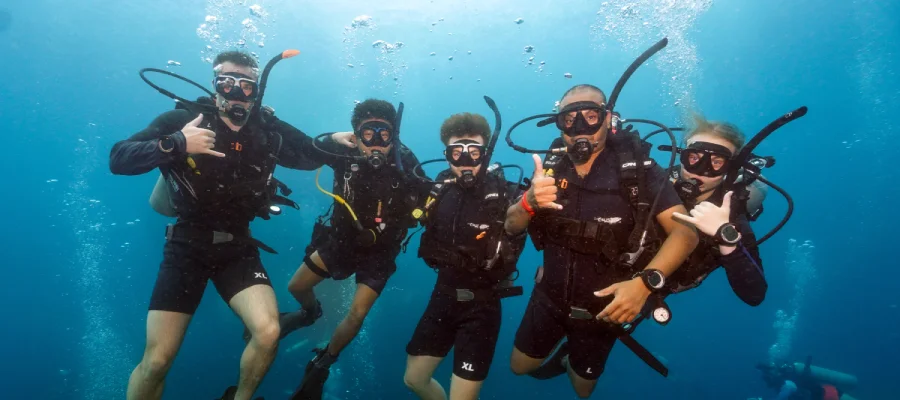
Best Time to Visit Koh Tao for Other Activities
At just over 20 square kilometers, Koh Tao may be small, but the island offers plenty to do beyond scuba diving, and the best time to visit Koh Tao for other activities depends on the weather.
For beach lovers, the March–May period is unbeatable. These months typically bring hot, sunny days, calm seas, and crystal-clear water that’s perfect for swimming, snorkelling, or simply relaxing on one of Koh Tao’s 20+ beaches. Sairee Beach, the island’s longest stretch of sand, comes alive during this season with sunset cocktails and a buzzing social scene, while secluded spots like Laem Thian Bay offer quiet, crowd-free escapes, accessible only by foot or boat.
If nightlife is more your style, Koh Tao’s famous jungle parties run year-round, including the massive Escobar party, which features five stages and music from both local and international DJs. Dry, calm-season evenings make for easier travel to and from the party, but even in the rainy season, events still happen as long as conditions are safe. Just remember that diving the morning after a big night out is not recommended due to alcohol, dehydration, and lack of rest.

When to Dive Koh Tao for Specific Experiences
Whale Shark Encounters
If you’re looking for whale sharks, the best time to visit Koh Tao is also when conditions are calm and water temperatures are higher. These gentle giants are filter-feeders, dining on tiny plankton. Warmer waters during this period trigger plankton blooms, creating an irresistible buffet for the ocean’s largest fish. To improve your odds, consider earning your Advanced Open Water certification since most whale shark sightings happen at deep pinnacle sites where a more advanced certification and depth limit are helpful.
Perfect Dive Photography
For stunning underwater photos, April is really hard to beat. Underwater visibility often peaks for the year, whale sharks are still around, and sunny skies make colours pop both above and below the surface. February and March can also deliver some spectacular days, with calm, mirror-like seas that reflect the perfectly blue sky.
Night Diving Adventures
Koh Tao offers incredible night dives year-round, from sandy bottoms with curious octopus to dramatic pinnacle dives and even UV night diving. The coral spawning season on Koh Tao is between February and April, so a perfectly timed night dive during a full moon could be your invitation to witness the completely synchronized creation of new coral colonies.
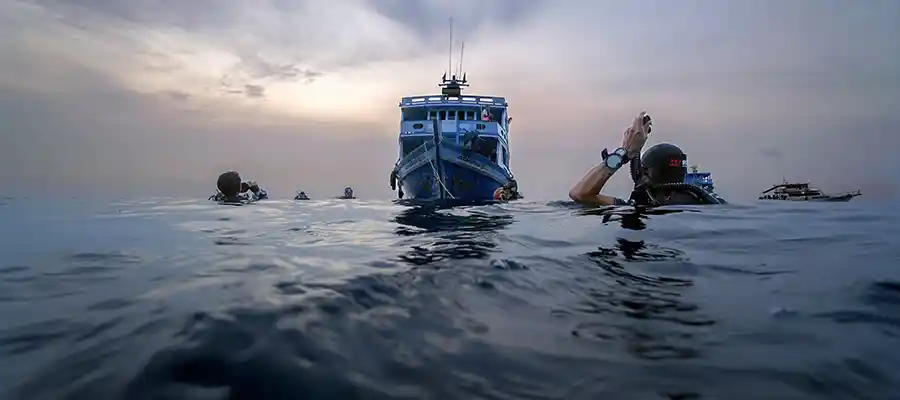
Tips for Planning Around Koh Tao’s Dive Conditions
From March to May, Koh Tao’s high season, accommodation fills quickly. In recent years, hostels and hotels have sold out completely during this period, so book well in advance. Check out our accommodation options here (we offer accommodation discounts if you choose to dive with us).
If you’re diving during the northeast monsoon (November–December), consider your comfort in cooler conditions. While we provide 3mm shorty wetsuits, you may prefer to bring your own wetsuit or rash guard. Warm clothes are also recommended for surface intervals, as wind and wet skin can make it feel surprisingly chilly. Many of our team wear jackets and hats that cover their ears because this season is the closest thing we have to “winter” here. Packing the right gear for the season will help you stay comfortable in all of Koh Tao’s dive conditions.
Traveling during the northeast monsoon adds a touch of unpredictability and adventure. Seas may be livelier, and schedules sometimes adjust with the weather, so it’s a good idea to allow extra time in your travel plans. Think of it as extra breathing room to explore, relax, or grab a couple more dives before heading onward.
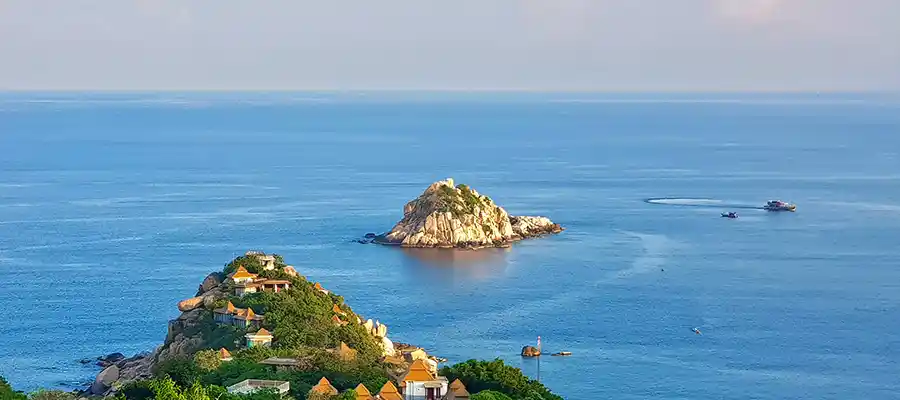
So, When’s the Best Time to Dive Koh Tao?
For many divers, the best time to visit Koh Tao is March to May, when calm seas, excellent visibility, and the high possibility of whale shark encounters combine for some truly unforgettable underwater adventures.
Can’t decide when to dive Koh Tao? Contact our team, and we’ll help you choose the Koh Tao diving season that matches your goals, skill level, and dream dives. We can also suggest the best courses, dive sites, and activities to make the most of your time on the island.
Follow Crystal Dive on social media to keep an eye on what’s happening on Koh Tao – weather updates, diving conditions, and stunning photos and videos of marine life sightings from our recent dives.

